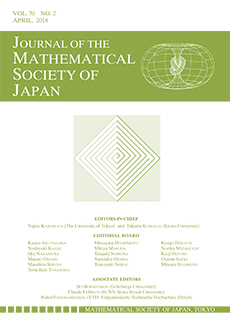Abstract
In this article, let or 1(mod4) be a fundamental discriminant, and let be the real even primitive character modulo . The series can be divided into groups of consecutive terms. Let be any nonnegative integer, an integer, , and let Then . In section 2, Theorems 2.1 and 2.2 reveal asurprising relation between incomplete character sums and partial sums of Dirichlet series. For example, we will prove that for integer if and . In section 3, we will derive algorithm and formula for calculating the class number of a real quadratic field. In section 4, we will attempt to make a connection between two conjectures on real quadratic fields and the sign of .
Citation
Ming-Guang LEU. "Character sums and the series with applications to real quadratic fields." J. Math. Soc. Japan 51 (1) 151 - 166, January, 1999. https://doi.org/10.2969/jmsj/05110151
Information





